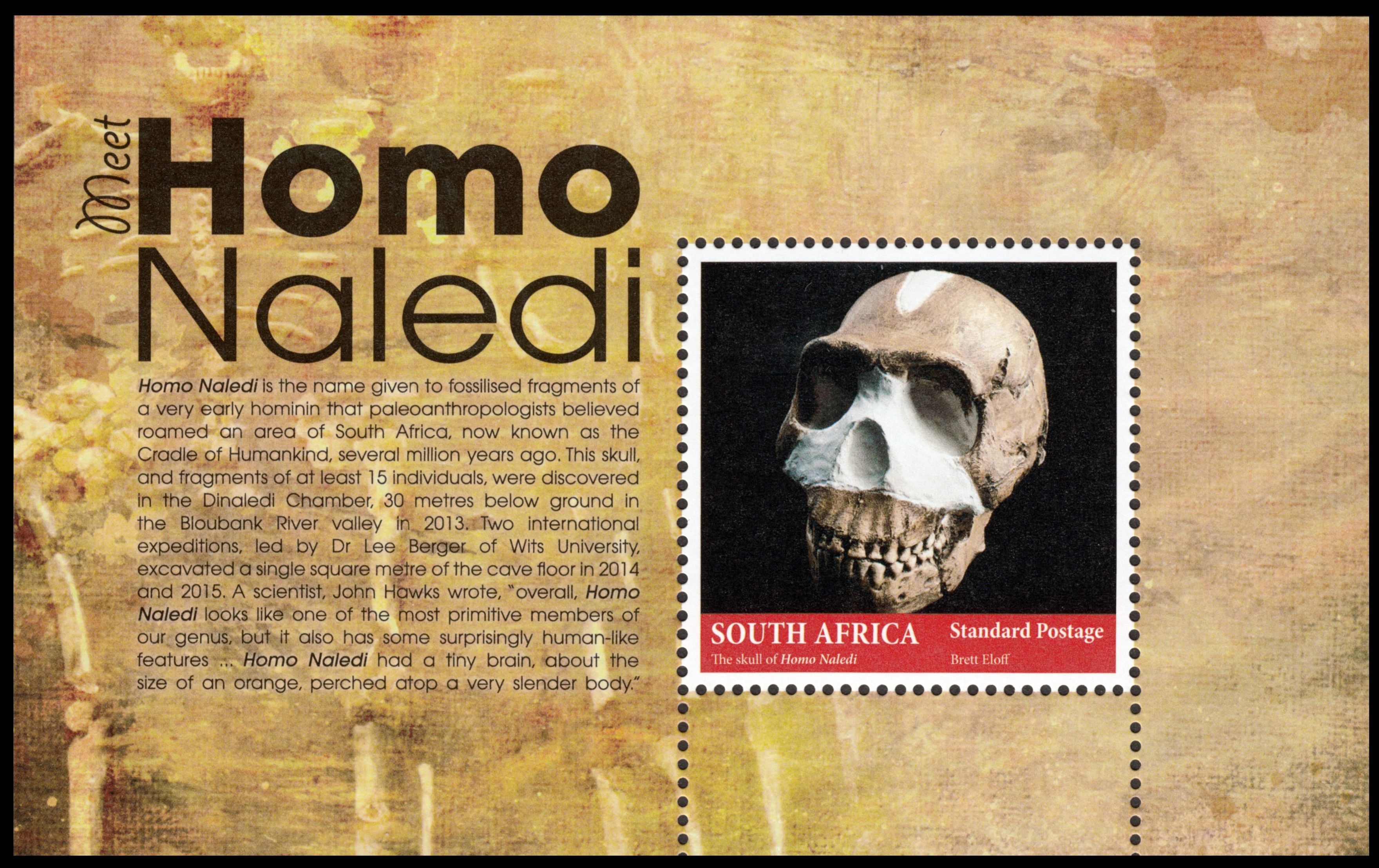Homo naledi Berger et al., 2015

(Da: it.wikipedia.org)
Phylum: Chordata Haeckel, 1874
Classe: Mammalia Linnaeus, 1758
Ordine: Primates Linnaeus, 1758
Famiglia: Hominidae Gray, 1825
Genere: Homo Linnaeus, 1758
Descrizione
Rinvenuto nel 2013 in Sud Africa nella Dinaledi Chamber, caverna facente parte del complesso delle Rising Star cave, l’Homo naledi è stato descritto come nuova specie nel 2015. L'età dei reperti non è nota con sicurezza, anche se recenti ricerche datano i fossili ad un periodo compreso tra 335.000 e 236.000 anni fa. Questa specie, alta circa 150 cm, mostra caratteristiche intermedie tra Australopithecus e Homo: la morfologia del cranio, della mandibola e dei denti sono simili a quelli delle altre specie di Homo, ma le dimensioni del cervello, grande all'incirca come un'arancia, sono comparabili a quelle di Australopithecus; gli arti inferiori hanno una forma molto simile a quella di Homo sapiens mentre la conformazione del bacino ricorda quella di Australopithecus afarensis; le proporzioni delle dita della mano sono simili a quelle dell'essere umano di oggi ma le falangi prossimali sono estremamente ricurve, anche in misura maggiore rispetto a qualsiasi australopiteco. La forma delle vertebre è simile a quelle delle specie del genere Homo del Pleistocene, mentre la cassa toracica si allarga nella parte inferiore come in Australopithecus afarensis.
Diffusione
I suoi resti fossili furono rinvenuti nel 2013 nelle Rising Star Cave, parte di un sistema di caverne del Sudafrica scoperte nello stesso anno. Nella caverna sono stati ritrovati oltre 1.500 elementi fossili, appartenenti ad almeno 15 esemplari diversi, il che fa dell'Homo naledi la specie fossile meglio conosciuta nella linea evolutiva dell'Homo sapiens.
Bibliografia
–Dirks, P. H. G. M.; Roberts, E. M.; Hilbert-Wolf, H.; Kramers, J. D.; Hawks, J.; et al. (2017). "The age of Homo naledi and associated sediments in the Rising Star Cave, South Africa". eLife. 6: e24231.
–Jump up to:a b Hawks, J. (2016). "The Latest on Homo naledi". American Scientist. 104 (4): 198.
–Jump up to:a b c Dirks, P. H. G. M.; Berger, L. R.; Roberts, E. M.; et al. (2015). "Geological and taphonomic context for the new hominin species Homo naledifrom the Dinaledi Chamber, South Africa". eLife. 4: e09561.
–Bolter, D. R.; Hawks, J.; Bogin, B.; Cameron, N. (2018). "Palaeodemographics of individuals in Dinaledi Chamber using dental remains". South African Journal of Science. Pretoria. 114 (1/2).
–Jump up to:a b c d e f g h Berger, L. R.; et al. (2015). "Homo naledi, a new species of the genus Homo from the Dinaledi Chamber, South Africa". eLife. 4.
–Jump up to:a b Hawks, J. D.; Elliott, M.; Schmid, P.; Churchill, S. E.; de Ruiter, D. J.; Roberts, E. M. (2017). "New fossil remains of Homo naledi from the Lesedi Chamber, South Africa". eLife. 6: e24232.
–Dembo, M.; Radovcic, D.; Garvin, H. M.; Laird, M. F.; Schroeder, L.; Scott, J. E.; Brophy, J.; Ackermann, R. R.; Musiba, C. M. (2016). "The evolutionary relationships and age of Homo naledi: An assessment using dated Bayesian phylogenetic methods". Journal of Human Evolution. 97: 17-26.
–Thackeray, J. F. (2015). "Estimating the age and affinities of Homo naledi". South African Journal of Science. 111 (11/12).
–Jump up to:a b c d e f Berger, L. R.; Hawks, J.; Dirks, P. H. G. M.; Elliott, M.; Roberts, E. M. (2017). "Homo nalediand Pleistocene hominin evolution in subequatorial Africa". eLife. 6.
–Sutikna, T.; Tocheri, M. W.; Morwood, M. J.; Saptomo, E. W.; Jatmiko; Awe, R. D.; Wasisto, S.; Westaway, K. E.; Aubert, M.; Li, B.; Zhao, J.; Storey, M.; Alloway, B. V.; Morley, M. W.; Meijer, H. J. M.; van den Bergh, G. D.; Grün, R.; Dosseto, A.; Brumm, A.; Jungers, W. L.; Roberts, R. G. (2016). "Revised stratigraphy and chronology for Homo floresiensis at Liang Bua in Indonesia". Nature. 532 (7599): 366-369.
–Jump up to:a b Schroeder, L.; Scott, J. E.; Garvin, H. M.; Laird, M. F.; et al. (2017). "Skull diversity in the Homolineage and the relative position of Homo naledi". Journal of Human Evolution. 104: 124-135.
Stringer, C. (2015). "The many mysteries of Homo naledi". eLife. 4: e10627.
–Allen, J. S.; Damasio, H.; Grabowski, T. J. (2002). "Normal neuroanatomical variation in the human brain: an MRI-volumetric study". American Journal of Physical Anthropology. 118 (4): 341-358.
–Jump up to:a b c Garvin, H. M.; Elliot, M. C.; Delezene, L. K. (2017). "Body size, brain size, and sexual dimorphism in Homo naledi from the Dinaledi Chamber". Journal of Human Evolution. 111: 119-138.
–Jump up to:a b Hollowaya, R. L.; Hurstb, S. D.; Garvin, H. M.; Schoenemann, P. T.; Vanti, W. B.; Berger, L. R.; Hawks, J. (2018). "Endocast morphology of Homo naledi from the Dinaledi Chamber, South Africa". Proceedings of the National Academy of Sciences. 115 (22): 5738-5743.
–Cofran, Zhongtao; Skinner, M. M.; Walker, C.S. (2016). "Dental development and life history in Homo naledi". American Journal of Physical Anthropology. 159: 3-346.
–Gautelli-Steinberg, D.; O'Hara, M. C.; Le Cabec, A.; et al. (2018). "Patterns of lateral enamel growth inHomo naledi as assessed through perikymata distribution and number" (PDF). Journal of Human Evolution. 121: 40-54.
–Kupczik, K.; Delezene, L. K.; Skinner, M. M. (2019). "Mandibular molar root and pulp cavity morphology in Homo naledi and other Plio-Pleistocene hominins" (PDF). Journal of Human Evolution. 130: 83-95.
–Jump up to:a b Irish, J. D.; Bailey, S. E.; Guatelli-Steinberg, D.; Delezene, L. K.; Berger, L. R. (2018). "Ancient teeth, phenetic affinities, and African hominins: Another look at where Homo naledi fits in" (PDF). Journal of Human Evolution. 122: 108-123.
–Elliott, M. C.; Quam, R.; Nalla, S.; de Ruiter, D. J.; Hawks, J. D.; Berger, L. R. (2018). "Description and analysis of three Homo naledi incudes from the Dinaledi Chamber, Rising Star cave (South Africa)". Journal of Human Evolution. 122: 146-155.

|
Data: 08/09/2017
Emissione: Incontro con l'Uomo di Naledi Stato: South Africa |
|---|

|
Data: 30/03/2018
Emissione: Uomini preistorici Stato: Sierra Leone Nota: Emesso in un foglietto di 4 v. diversi |
|---|